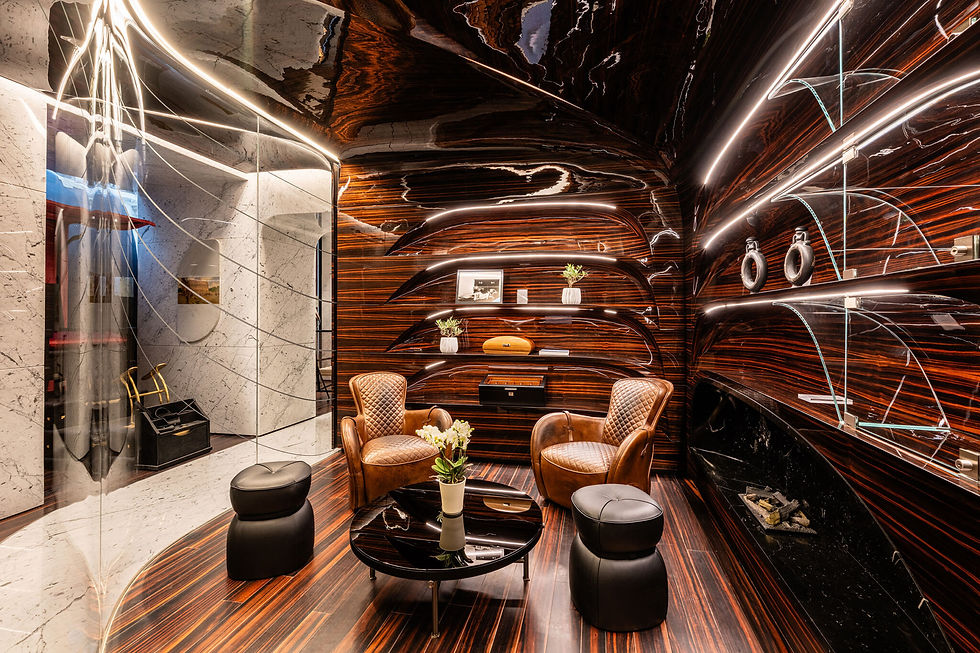
罗密欧罗马酒店
扎哈·哈迪德建筑事务所
项目名称:罗密欧罗马酒店
设计团队:扎哈·哈迪德建筑事务所
项目地点:罗马,意大利
建筑类型:酒店改造
客房数量:74间
竣工时间:2024年
摄影师:Chris Dalton,Jacopo Spilimbergo
设计特色:
项目 – 扎哈·哈迪德建筑事务所将罗马一座16世纪的宫殿改造成豪华酒店,通过对传统罗马拱顶的重新诠释,在历史建筑与当代设计之间创造出引人注目的对话。罗密欧罗马酒店展现了该事务所标志性的流动美学,同时保留了这座建筑跨越五个世纪的历史元素。
在项目总监保拉·卡塔林的带领下,这项翻新工程从罗马建筑的层积性——不同历史时期的叠加——中汲取灵感,特别关注该城市的拱顶传统。建筑师将这一建筑元素作为概念基础,发展出一种当代诠释,从天花板设计延伸到家具,在整个空间中创造出连贯的设计语言。
这家拥有74间客房的酒店的特色在于每个空间都经过独特设计,摒弃了酒店建筑的典型模块化方法。相反,每个房间都呈现出独特的空间配置,响应宫殿不规则的几何结构。设计团队开发了一个精妙的"第二表皮"解决方案,在保护原有建筑的同时将现代设施整合到历史建筑中,在现有墙壁和新室内表面之间创造一个薄腔来容纳技术设施。
在这项需要230个不同建筑许可并涉及49家公司的翻新工程中,工人们发现了一个此前未知的古罗马工作坊,其特色是块菱形石砌面(opus reticulatum)——一种有2000年历史的砌筑方式。这一考古发现被保留下来,通过花园下方的90平方米展览厅融入酒店设计中,可以通过酒店游泳池的玻璃地板观赏。
该项目展示了历史保护与当代设计的巧妙融合,卡拉拉白色雕像用大理石、马卡萨黑檀木和黄铜等材料营造出丰富的层次感室内空间,呼应着建筑累积的历史,同时开启了其建筑演变的新篇章。
团队 – 扎哈·哈迪德建筑事务所(Zaha Hadid Architects, ZHA)由已故普利兹克奖得主扎哈·哈迪德于1979年创立,如今已发展成为世界上最具影响力的建筑事务所之一。目前,ZHA以员工福利信托(Employee Benefit Trust)的形式运营,由首席建筑师帕特里克·舒马赫(Patrik Schumacher)领导。总部位于伦敦克拉肯维尔,该事务所拥有约500名员工,持续推动参数化设计与计算建筑的界限。
ZHA以其独特的建筑语言而闻名,其特点是流线型几何和创新的空间概念。在公共、文化和商业领域,ZHA始终交付具有开创性的项目,其代表作品包括罗马的MAXXI国家21世纪艺术博物馆(2010年斯特林奖)、巴库的海达尔·阿利耶夫文化中心,以及北京大兴国际机场航站楼。
自2016年舒马赫接任领导以来,事务所在技术能力上实现了显著扩展,特别是成立了专注于人工智能驱动设计方法的部门——ZHAI(Zaha Hadid Analytics + Insights)。事务所的当代作品继续展现其对研究导向建筑、可持续创新以及复杂几何优化的承诺,同时保持了其在城市融合与场地响应方面的标志性方法。最近完成的项目如阿联酋BEEAH总部,展示了ZHA在结合参数化设计与环保意识方面日益成熟的专业水平。
Project Name: Hotel Romeo Roma
Design Team: Zaha Hadid Architects (ZHA)
Location: Rome, Italy
Building Type: Hotel Renovation
Number of Rooms: 74
Completion: 2024
Photographer:Chris Dalton,Jacopo Spilimbergo
Feature:
Project - Zaha Hadid Architects has transformed a 16th-century palazzo in Rome into a luxury hotel, creating a striking dialogue between historical architecture and contemporary design through a reinterpretation of traditional Roman vaults. The Hotel Romeo Roma, located on Via di Ripetta near Piazza del Popolo, showcases the firm's signature fluid aesthetics while preserving the building's historical elements spanning five centuries.
Led by project director Paola Cattarin, the renovation project takes inspiration from Rome's architectural palimpsest - the layering of different historical periods - with a particular focus on the city's tradition of vaulted ceilings. The architects used this architectural element as a conceptual foundation, developing a contemporary interpretation that extends from the ceiling designs to the furniture, creating a cohesive design language throughout the space.
The 74-room hotel features individually designed spaces that reject the typical modular approach of hotel architecture. Instead, each room presents its own unique spatial configuration, responding to the palazzo's irregular geometry. The design team developed a sophisticated "second skin" solution to integrate modern amenities within the historical structure, creating a thin cavity between the existing walls and new interior surfaces to house technical services while preserving the original architecture.
During the renovation, which required 230 different building permissions and involved 49 companies, workers discovered a previously unknown Roman workshop featuring opus reticulatum - a 2,000-year-old diamond-shaped stone facing. This archaeological finding has been preserved and incorporated into the hotel design through a 90-square-meter gallery beneath the garden, visible through the glass floor of the hotel's swimming pool.
The project demonstrates a masterful blend of historical preservation and contemporary design, where materials such as Carrara Statuarietto marble, Makassar ebony, and brass create rich, layered interiors that echo the building's accumulated history while establishing a new chapter in its architectural evolution.
Design Team - Zaha Hadid Architects (ZHA), established in 1979 by the late Pritzker Prize laureate Zaha Hadid, has evolved into one of the world's most influential architectural practices, now operating as an Employee Benefit Trust under the leadership of Principal Patrik Schumacher. With headquarters in Clerkenwell, London, the 500-strong firm continues to push the boundaries of parametric design and computational architecture.
Known for their distinctive architectural language characterized by fluid geometries and innovative spatial concepts, ZHA has consistently delivered groundbreaking projects across civic, cultural, and commercial sectors. Their portfolio includes iconic works such as the MAXXI Museum in Rome (Stirling Prize 2010), the Heydar Aliyev Center in Baku, and the Beijing Daxing International Airport terminal.
Under Schumacher's direction since 2016, the practice has expanded its technological capabilities, notably establishing ZHAI (Zaha Hadid Analytics + Insights), a dedicated unit exploring AI-driven design methodologies. The firm's contemporary work continues to exemplify their commitment to research-driven architecture, sustainable innovation, and complex geometry optimization, while maintaining the practice's signature approach to urban integration and contextual response. Recent projects like the BEEAH Headquarters in UAE showcase their evolving expertise in combining parametric design with environmental consciousness.
74间
罗马,意大利
2024























